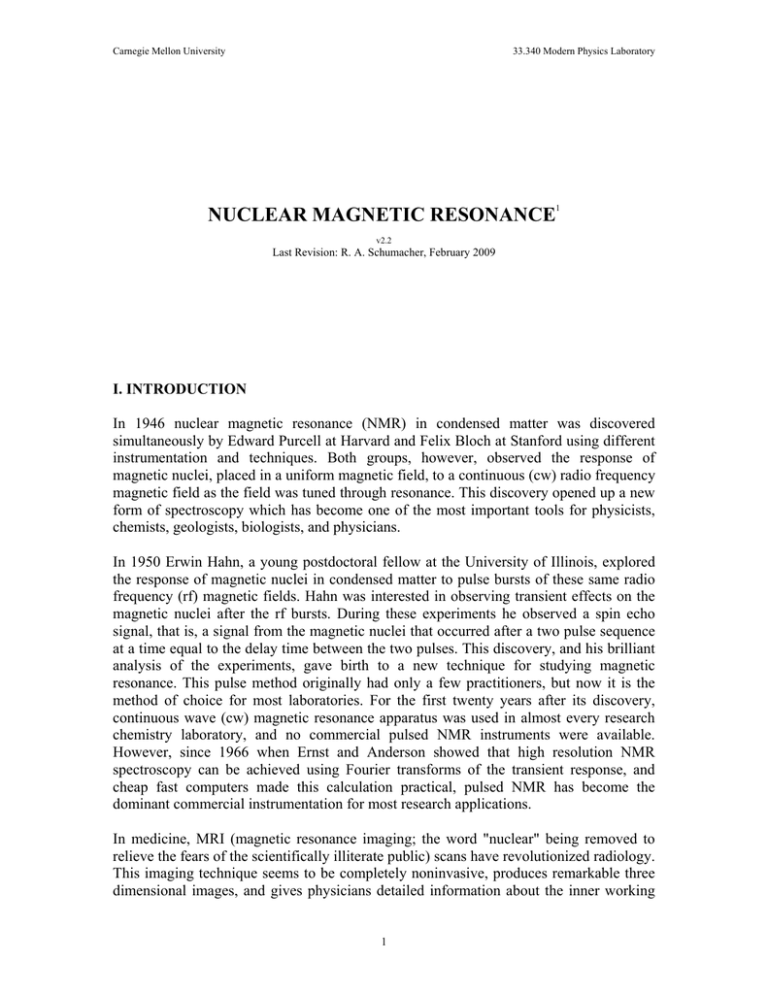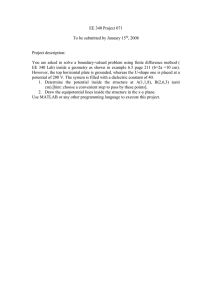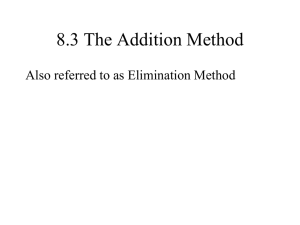Guide - Physics 122
advertisement

NUCLEAR MAGNETIC RESONANCE
I. INTRODUCTION
33.340 Modern PhysicsLaboratory
CarnegieMellon University
of living systems.For example, preliminary work has already shown that blood flow
patternsin both the brain and the heart can be studiedwithout dangerouscatheterization
or the injection of radioactive isotopes.MRI scansare able to pinpoint malignant tissue
without biopsies,and we will see many more applicationsof this diagnostictool in the
coming years. The scansrely on measuringthe "T1" and "T2" values in various body
tissues:in this experimentyou will learn what theseare and how to measurethem for a
smallsample.
You will be using the first pulsedNMR spectrometerdesignedspecifically for teaching.
The PSI-A is a complete spectrometer,including the magnet, the pulse generator,the
oscillator, pulse amplifier, sensitivereceiver,linear detector,and sample holder. Many
can be studied.
substances
Now you are ready to learn the fundamentalsof pulsed nuclear magnetic resonance
spectroscopy. We recommend that for this laboratory experiment you proceed as
follows:
1) Readabout nuclearspin and spin precession[start with SectionIII, below) so
you graspthe basicideas.
2. Readthe discussionin SectionIV to becomefamiliar with the equipment.
3. Start a seriesof measurementsas outlinedin SectionV. Go as far as you can
in the time available. Quality of results is more important than quantity.
II. BACKGROUND READII\G
Nuclearmagneticresonanceis a vast subject.Tens of thousandsof researchpapersand
hundredsof books have beenpublishedon NMR. We will not attemptto explain or even
to summarizethis literature.An extensiveannotatedbibliography of imporlant papersand
books onthe subjectis provided atthe end of this section.The following referencesmay
provideadditionaluseful backgroundfor the experimentand should be perused:
Reference
Sections
Paqes
8 .1 - 8 .4 .1 340-359
8 .4 .2- 8 .4 .4 36r-374
443-45r
Cohen-Tannoudji3 F(rv)
Melissinos2
Topics
Magnetic Resonancebasics
Detection(but not the MPL way)
Quantumvs classicaldescriptions
III. THEORY OVERVIEW
J
J j
jU
U B
U z B mz B
mz
mz j j j j
jmz
m z
U B
o B
fBo
"Relaxation" along the external field:
NN
NN
o
U
N
kT
e
e kT
N
M z N N
N N + N
B
B
M o N
N
kT
kT
Exercise 1: Derive Eq. III.12 from the preceding two equations
not
dM z M o M z
dt
T
Mz
M z t M o e t T
Phase decoherence of the spins with respect to each other:
x-y
dJ
dJ
B
dt
dt
d
B
dt
Exercise 2: Show that the precessional frequency, o, is just the
resonant frequency in Equation III.7.
x-y
create
x-y
dM
M B
dt
B
Bo z
x-y
B t B t x B t y B z
rotating coordinate system
effective
field
B z
rotating
z
B z
Beff t B x B z
dM
M Beff
dt
x B t x
B t x t y B t x t y
Bo Bo o
Beff t B x x z
x-y
x-y
z
net
magnetization precessing about the constant magnetic field Bz in the x-y plane. Nothing
Else!
x-y
B z x-y
x-y
tw
tw
tw
B
dM y
M y
dM x
M
x
dt
T
dt
T
M x y M o e t T
B z distribution
x-y
x-y
The need for pulse sequences:
t
rotating
x-y
M x y t M o e
T
x-y rotating
x-y
summarize
o B
fBo
dM
M B
dt
B t B t x B t y B z
Beff t B x B z
Bo o Beff t B x
x-y
IV. EXPERIMENTAL EQUIPMENT
x-y
Do not move the carriage initially. Chances are it is already set at its "sweet spot" where
the magnetic field is most uniform.
x-y
This is the detector that you will use to record both the free
induction decays and the spin echoes signals
V. EXPERIMENTAL PROCEDURE
V.1 Learning to use the equipment:
x-y
V.2 Getting a FID signal and tuning the receiver circuitry
x-y
V.3 Measuring T2* for glycerin
x-y
z
x-y
z
C a r n e g i eM el Io n Un ive r sify
33.340ModernP hysi csLabora tory
direction. But this magnelrzationbuilds exponentially with a time constant, T1. Each
Measurement,that is, eachpulse sequence,must wait at least 3 T1 (preferably 6-10 T1's)
before repeatingthe pulse train. For a single pulse experimentthat means a repetition
time of 6- 10 Tr. If you chosepure wateras a sample,with Tr = 3 sec,you would haveto
wait a half a minute betweeneach pulse. Since severaladjustmentsare required to tune
this spectrometer,pure water sampleswould be very time consuming and difficult to
work with. The effect of not fully recoveringthe z magnetizationbetweenpulse trains is
calledsaturation.
Glycerin has a T1 of roughly 20 ms at room temperature.That meansthe repetitiontime
e.rrrbe set 100 urs and the magnettzationwill be in thermal equilibrium at the start of
cachpulse sequence(or single pulse in this first experiment).
The actualshapeof the Tr- is not exponential,but proportionalto /,(O)/O, where ,/,(@)
is the Besselfunction of order I , @ : yGdt12, d is the samplediameter,and G is the
field gradient dB,I dz. For now, simply characterrzethe shapeby its width:
Estimate T2* for glycerin by finding and recording the full-width at half maximum
(FWHM) of the FID signal.
V.4 Quick First Estimateof the Spin-LatticeRelaxationTime, 71,.for glycerin.
The time constantthat characterizesthe exponential growth of the magnetizationtowards
thermalequilibrium in a static magneticfield, T1,is one of the most impoftant parameters
to measureand understandin magneticresonance.With the PSl-A, this constantcan be
measureddirectly and very accurately.It also can be quickly estimated.Let's stafi with an
order of magnitudeestimateof the time constantusing the standardglycerin sample.
1. Adjust the spectrometerto resonancefor a singlepulse free induction decaysignal.
2. Changethe RepetitionTime, reducingthe FID until the maximum amplitudeof the
FID is reducedto about 1/3 of its largestvalue.
The order of magnitudeof Tr, is the repetitiontime that was establishedin step2. Setting
the repetition time equal to the spin lattice relaxation time does not allow the
magnetrzationto return to its thermal equilibrium value before the next 90o pulse. Thus,
the maximum amplitude of the free induction decay signal is reducedto about l/e of its
largestvalue. Such a quick measurementis useful, since it gives you a good idea of the
time constantyou are trying to measureand allow you to set up the experimentconectly
the first time.
V.5 Two-Pulse Zero-CrossingMethodfor T1
A two pulse sequencecan be usedto obtain a two significantfigure determinationof Tr.
The pulsesequenceis:
23
cannot detect
x-y
x-y
just before the pulse
V.6 A Better Two-Pulse Method for T1
x-y
V.7 Spin-Spin Relaxation Time - T2 for glycerin
V.8. Two-Pulse Spin Echo Method
x-y
t
T
V t V e
33.340 Modern PhysicsLaboratory
C a m e g i eM e llo n Un ive r sity
fitting algorithm. Make a good
exponentialcurve directly with a non-linearleast-squares
for glycerin using the two-pulseecho method. Measurethe height of the
T2 me&surement
spin echo for enough values of r using the two-pulse echo method and extract a value
(using a fit) for T2.
Thereare severalissues,someinherentin the apparatus,someinherentin the physics,
that can result in the datanot lying on a straightline. Thesecan be classifiedas:
1. 'Nonlinearities'in the detectorresponse.
2. Errors causedby improperuse of the digital scope.
3. The actualdecaymay not be exponentialunder the conditionsof the two pulse
experiment,fot somesamples.
are
discussedhere:
They
1. The echo amplitude is to be measuredby using the output of the rectifring detector,
not the phase sensitive detector,becausethe latter can be subject to small but easily
observedfluctuationsand the relative phaseofthe referenceand the signal are not under
,experimentalcontrol. However, the signal detectionrectifier responseis nonlinear at low
signal levels due to 'noise'. This can be easily seenby examining an echo amplitudethat
decaysexponentially with t at high signal levels, but non-exponentiallyat low signal
levels. One can go from one regime to the otherjust be changingthe gain of the receiver
amplifier. For our purposes,no signal less than about 0.4 volts should be usedfor
amplitude measuremenlsunless you include corrections for the detector nonlinearity.
How to identify and compensatefor this effect is an exerciseleft to the student. Discuss
it with the instructor.
2. In earher times, the limited sampling rate of digital oscilloscopescould cause a
particularillusion in what is seencalled "aliasing". Beats in the FID signal at the scope
samplingfrequencywill show up on the digital scopeas a "flat" trace. If the spin echoes
aretoo narrow,i.e.,too brief in time, then displayof a chain of them on the digital scope
will result in large fluctuationsin the apparentamplitudeof eachof them. That is because
eachscreenof the scopesamplesthe input waveform only finite number of times. If the
echo is too sharp for the sampling rate used it has information in a frequency range
exceedinghalf the sampling rate. Fortunately,with present-dayscopesthis problem
rarely showsup.
3. Physicaldiffusion of the spins in the sample:real physics. A spin randomly diffuses
from one region to another in the sample. Since those regions have different static
magneticfields becauseof field inhomogeneity,the random movementwill causeloss of
phasememory of the spins. That phasememory loss occurs at a more rapid rate than
simple exponentialdecay:
V (l : 2 r)= V o € " i u -T
(v.2)
where
a = D(ydB,la)z ltZ
26
(v 3)
DdB/dz
t
D
V.9 Multiple Pulse Spin Echo Sequences for T2.
independently
t
T
V t n V e
e
C a r n e g i eM e llo n Un ive r sity
33.340Modern PhysicsLaboratory
Now measureT2 fbr glycerin using M-G pulse sequence. Comparethis result with your
previousresult using the two-pulse method. Try to separatethe effect of diffusion from
the value of Tz.
V.l0 Better Estimateof Diffusion Effects
We can use the vadous pulse sequencesto separatethe spin-spinrelaxationand diffusion
effectson the echo.If the time betweenthe nl2 and the n pulse in the M-G sequenceis t,
the echoesoccur at t":n(2r). From Equation V.2, using the fact that the echoesare
equally spacedand the differencebetweenany two is equalto t;2 c
_
V (t,' 1:V (t,-r)
e-attre
tl
' t2
(v.5)
Recursiveapplicationof this relation gives
ar!
v(t, :2nr ) :v( 0) e- "n"s "
(v 6)
If one usesa single pulse to createan echo at a time tn,lhen the required delay is nt, and
the echoheisht after that time is
Vr(t,):V(0)
, _,,'
1'2
u-a(nr'')'
u
(v 7)
The ratio, R, of Equation (6) to Equation (7) is
R( t , =2 n t )
= n - a ( n r - n ) ( r ') l
(v 8)
Thus, a plot of ln(R) vs. (n3-n)would have a slope of cxtr3. Notice that T2 has canceled
out. You now have a method to measurethe effectsof difTusionthrough the field gradient
of the magnet, u:D(ydB/dz12ll2. Another test of the B pulse length being incorrect is
that the points in the plot of ln(R) vs. (tt'-n) will alternate around the best fit line drawn
throughthem, a clear indication that the M-G sequencedoesindeedcorrectthe error from
one pulse on the next pulse. Correctadjustmentof the length of the B pulse will minimize
that alternation.
Use the two-pulse and the M-G measurementstogether to determine D(ydBldz)z for
glycerol. Then consult the appendix "Estimating Field Gradients from Signal Decay
Shapes"to estimatedBldz, and therebyobtainthe diffusion coefficient D.
V.l l Examiningwater
Try thispart of the lab only f you havesuccessfullycompletedthepreviousparts.
Use the simple method describedin SectionV .4.2 to get an estimateof Tr for distilled
water. The full measurementwould be tough. We can shoften the relaxation times by
addingparamagneticCu** ions to the water. Why? A CuSO+(cupric sulfate) solutionhas
been prepared.For this solution, measureTr and then T2 using the two-pulse and M-G
29
V.12 Other Interesting Behavior
Try this part of the lab only if you have successfully completed the previous parts.
V.13 Magnetic Field Contours
Try this part of the lab only if you have successfully completed the previous parts.
x-y
x-y
V.14 Rotating Coordinate Systems
This part is easy and may help you grasp the way the spin vectors respond to the static
and the rotating fields.
is
APPENDIX A: ADDITIONAL DETAILS ABOUT THE EQUIPMENT
Pulse Programmer PP-101
Leave in during MPL experiments.
15 MHz OSCILLATOR/AMPLIFIER/MIXER:
IMPORTANT: DO NOT OPERATE THE POWER AMPLIFIER WITHOUT
ATTACHING TNC CABLE FROM SAMPLE PROBE. DO NOT OPERATE THIS
UNIT WITH PULSE DUTY CYCLES LARGER THAN 1%. DUTY CYCLES
OVER 1% WILL CAUSE OVERHEATING OF THE OUTPUT POWER
TRANSISTORS. SUCH OVERHEATING WILL AUTOMATICALLY SHUT
DOWN THE AMPLIFIER AND SET OFF A BUZZER ALARM. IT IS
NECESSARY TO TURN OFF THE ENTIRE UNIT TO RESET THE
INSTRUMENT. POWER WILL AUTOMATICALLY BE SHUT OF TO THE
AMPLIFIER IN CASE OF OVERHEATING AND RESET ONLY AFTER THE
INSTRUMENT HAS BEEN COMPLETELY SHUT OFF AT THE AC POWER
ENTRY.
15 MHz Receiver
not
Auxiliary Components (not used in present MPL setup)
References
Experiments in Modern Physics,
Quantum Physics
Quantum Mechanics
Data Reduction and Error Analysis for the
Physical Sciences,
Books
Papers
Carnegie Mellon University
33.340 Modern Physics Laboratory
Estimating Field Gradients from Signal Decay Shapes
Last Revision: R. A. Schumacher March 2008
ver. 1.5
I. INTRODUCTION
In the NMR experiment, the “free induction decay (FID)” shape is a result of a slightly
non-uniform magnetic field across the volume of the sample. In the Optical Pumping
experiment, the decay of the Rabi oscillations may similarly be dominated by nonuniform magnetic field across the rubidium cell. The “decay” phenomenon seen in the
two experiments is similar enough that we can discuss the physics for both at once. In
both cases we can use the experimentally determined “zeros” of the decay distribution to
estimate the magnetic field gradients in the samples.
II. COMPUTING THE LINE SHAPE
G
The general arrangement is shown in Figure 1. Let the static magnetic field B0 be
oriented along the z axis. The spins in the sample are initially oriented along this field.
The geometry of the sample in not crucial, but for discussion assume it is a cylinder of
length L and cross sectional area A.
G
B1 (t )
y
A
L/2
dy
x
G
B0
G
M
z
L/2
Figure 1: Let the
magnetic field be in the z
direction. The sample is
a cylinder of length L
and area A.
The
magnetization
vector,
G
M , of the spins in the
sample initially points
along the static field
G
B0 Bz z .
G
In both experiments the direction of the magnetization M (loosely called “spin”) is
changed using the same physical mechanism: a weak transverse oscillating magnetic field
G
B1 (t ) B cos Z0t xˆ is applied for some duration of time. Classically, the frequency Z0 of
this transverse RF (radio frequency) field must be matched to the Larmor frequency of
G
the atoms in the strong static field B0 . Given that
G
Z0 J B0 ,
(1)
1
Carnegie Mellon University
33.340 Modern Physics Laboratory
where J is the gyromagnetic ratio of the material under study, one can find the frequency
if the field strength is known. In the NMR experiment, the frequency is near 15 MHz,
while in the optical pumping experiment it is near 50 kHz. To measure a signal, in the
NMR experiment we activate the oscillating field long enough to rotate the spins into the
x-y plane, and then observe the net magnetization in this plane as a function of time. In
the optical pumping experiment, we activate the oscillating field indefinitely, sending the
spin angles through many full cycles of resonance, and observe the degree of opacity of
the rubidium cell versus time using a photodiode detector.
In the quantum mechanical picture, the Larmor frequency turns out to be related to the
transition energy between the magnetic sub-states of the system. The splitting of the
energies of the sub-states is caused the Zeeman Effect. That is, if the magnetic sub-states
are separated by energy 'E , then we have 'E =Z0 . This relationship between the
quantum and classical pictures is not obvious at all, but comes from the study of spin and
magnetic moments at the level of the Advanced Quantum Physics course. For this
discussion, the classical picture is entirely sufficient.
G
Now suppose that the static field B0
Bz ( x, y, z ) z is not perfect, and that across the
volume of the sample there are field gradients wBz / wx , wBz / wy , and wBz / wz . That is, in
different locations in the sample the static field is slightly different, and hence the Larmor
frequency is slightly different. Hence the spins precess about the static field at slightly
different rates, and the coherence of the detected signal goes away after some
characteristic time. That time is related to the strength of the field gradients and the size
of the sample. The “line shape” of this loss of coherence is what we are calculating in
this note.
For definiteness, suppose the gradient wBz / wy is the only non-zero one we have to
consider. Let the response signal of the detector to spins at location y1 be written
dS1 (t )
Ady cos Z1t ,
(2)
and the response at a different location y2 be written
dS 2 (t )
Ady cos Z2t ,
(3)
where Ady are the separate differential volume elements across which the responses are
detected. Ady is to be construed as proportional to the number of spins in the sample
volume and also their net magnetization. The two y locations are not the same and can be
a macroscopic distance apart. The combined response from these two locations is then
dS (t )
Ady (cos Z1t cos Z2t ) .
dS1 (t ) dS1 (t )
Using a trigonometric identity, this is the same as
2
(4)
Carnegie Mellon University
33.340 Modern Physics Laboratory
§1
·
§1
·
(5)
2 Ady cos ¨ (Z1 Z2 )t ¸ cos ¨ (Z1 Z2 )t ¸ .
©2
¹
©2
¹
Even though the y locations can be a finite distance apart, we suppose that the frequency
difference between them is still very small, so that we may write
dS (t )
Z1 Z2 o 'Z J'Bz
J
dBz
( y1 y2 ) .
dy
(6)
This equation assumes that the change in magnetic field strength across the sample is
well characterized by a gradient and a separation. Put the origin at the center of the
sample, and let the two locations in y be symmetric above and below y = 0, so that we
have
Z1 Z2
J
dBz
2y .
dy
(7)
For each separation of the response locations specified by y, we must include a
“weighting” factor to account for all possible ways we can have two places in a sample of
length L separated by distance 2y. Since the sample of length L, the room within which
we can place a segment of length 2y is L2y. The dimensionless factor is taken to be
(12y/L).
We have also assumed that the spread in frequencies is so small that the bandwidth of the
driving RF field is wide enough to “excite” the spins across the whole sample. If this
were not the case, then only a sliver of the whole sample would respond to the oscillating
magnetic field. Thus, we can define the average frequency to be equal to the driving
frequency:
1
(8)
(Z1 Z2 ) { Z0 .
2
With these replacements we can write Eqn. (5) as
dS ( y, t )
§ dB
·§
y·
2 A cos Z0t cos ¨ J z t y ¸ ¨ 1 2 ¸ dy .
L¹
© dy
¹©
(9)
To determine the overall response of the detector to this range of oscillatory actions
within the sample we must now integrate this expression over the height of the sample.
To make the integral symmetric, we will take half the result of integrating from –L/2 to
L/2. That is,
L /2
§ dB
·§
y·
S (t ) ³ dS ( y, t ) A cos Z0t ³ cos ¨ J z t y ¸¨1 2 ¸ dy .
(10)
L¹
© dy
¹©
L /2
Introduce, for convenience, the combination
3
33.340Modern PhysicsLaboratory
C a r n e g i eM e llo n Un ive r sity
,
t. - ".d8, l.
K=y
,
ay
( 11)
so that we can write, with the further substitution I = k y ,
L/2/\
12 I
e
,.,l
A c os( a4r )J cos( @)1[ 2;]dy
s(r;= tas6,t1=
.
.l
L)
\
- t,J
r
.
I
?
.
= A c os( anr ) ;lcos(i) ,li + . lcos(i) i di
'
J
'" 'k r
(r2)
k'
2sinkL
: Acos(atnt\-- .2
+
0
Ir
L
The second integral vanishes becausewe are integrating an odd integrand over the
symmetricrange from-Ll2to +L12. This line shapefunction S(t) can be rewritten in a
more comDactform if we make the substitution
(D (/ )= k. L--v
2
d B' -L
-1
dy2
.
( 13 )
so that we have
sin@(r)
s(/) = AL cos(atot,
@(r)
( 14)
This is our main result: it is the "line shape"of the detectorresponseof a samplein which
not all elementsare oscillating at the samefrequency. Note that the signal is proportional
to the samplevolume AL, as one would expect. At time / : 0 the signal is just AL, as can
be seenfrom the first term of the Taylor expansionof the sine. The function sin (D/ O is
the "sinc" function, which looks like a sine multiplied by a hyperbola. It has its first zero
maximum near@:3n12. This is the featurewe can
when @ =Tt, andthen a subsequent
exploit to estimatethe size of the field gradient.
In reality, additional derivatives of B will be nonzero. For the cylindrically
imp lie s t ha t
V' B :0
of
the
PS-1A magnet,
symmetric field
:
:
:
dB,fdx dB,,fdy -G 12<0 and aB,fdz G >0, wherez is the symmetry axis. For a
the freeinduction envelooeis now
cylindricalsample,asin the presentexperiment,
vGdr 12)
.. J,(
'"
M(r\:2^M^
" yGdr12
[1s)
where d is the sample diameter and ./,(x) is the Besselfunction of order 1-. It is
oscillatory but not periodic. To measure the gradient G, measure the time t
correspondingto the first zero of Jr(x), which occurs at approximately x = 3.83.
This is most accuratelymeasuredusing an echo,to eliminateuncertaintyassociated
with preamp recoverytime following a 90opulse.




